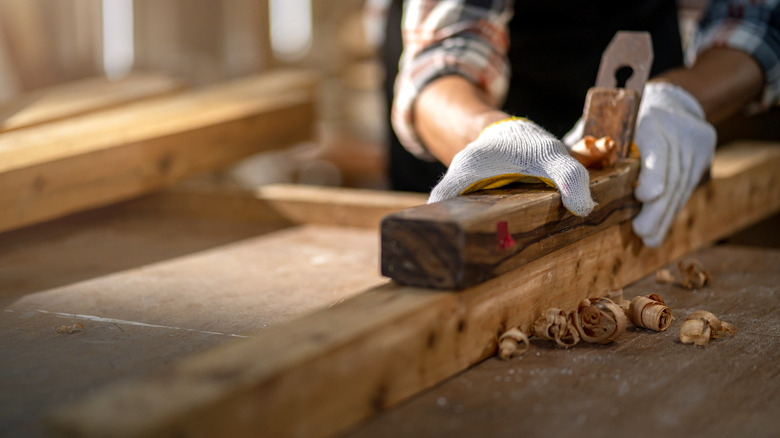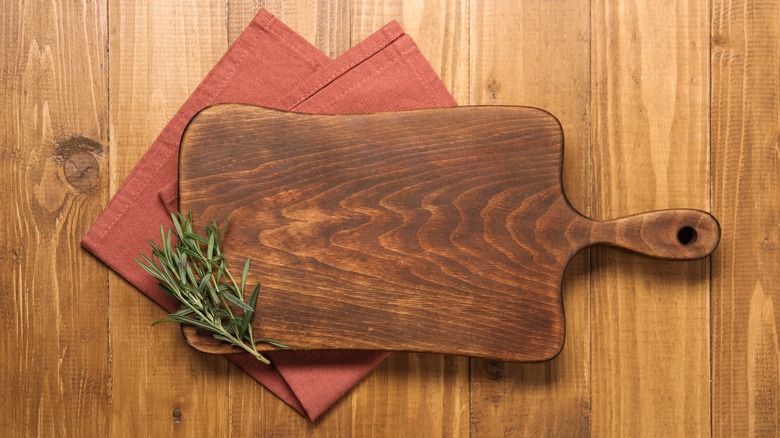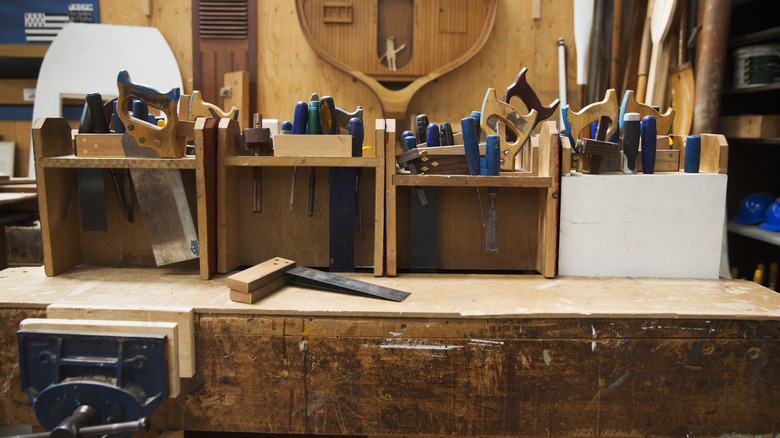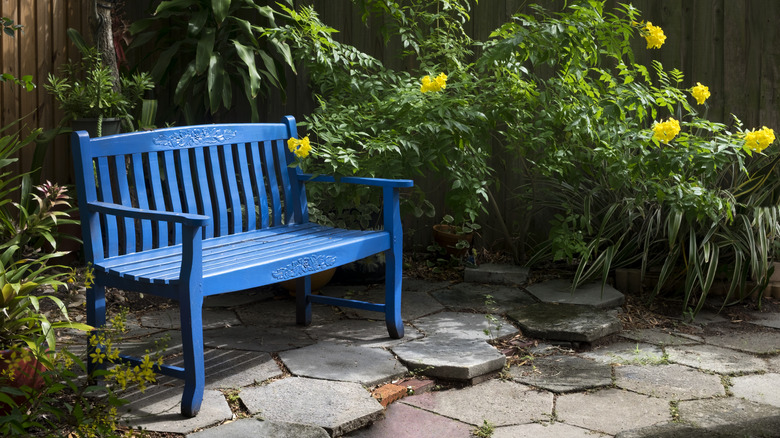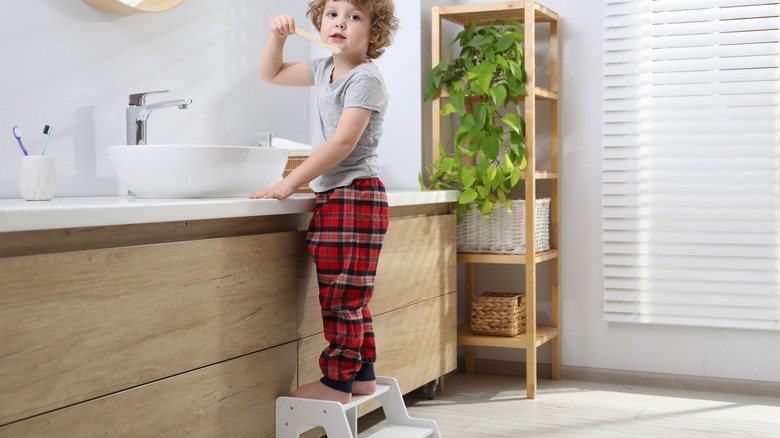10 Small Woodworking Projects That Are Great For Beginners
The life of a woodworker is one filled with imprecise mistakes. Whether you're taking your first steps in the shop or are a steady hand at the table saw (such as a jobsite saw or a substitute for the cutting tool), you're bound to experience triumphs and setbacks at a constant pace. Growing your skill here involves a wide swath of projects. From building boxes to trying your hand at furniture making, as a woodworker you'll encounter a huge catalog of opportunities.
With some essential safety accessories in tow, your functional range can be expanded significantly in the early days with the help of a tight list of essential projects. Boxes are a natural inclusion here. The box is a foundational element that will support just about every other task you take on. But no one wants to fabricate countless boxes as they build their skills. A few other projects come to mind and can make a big difference in the functionality of your home, too. Woodworking is a great way to build things that will improve your lifestyle with a renewable resource that isn't particularly difficult to manipulate. As a woodworker just getting into this world and seeking to expand your skillset, these are some of the best small projects to cut your teeth on and instill confidence in your capabilities.
Cutting boards
A cutting board is a great starting point for those just getting into the world of woodworking. Cutting boards are essentially a flat plank of wood with a bit of additional preparation work imparted into the fibers. The most basic of cutting boards can simply be sawn and flattened before adding a finish to the creation. On the other hand, shaping boards into rounded dimensions or utilizing end grain or book-matched patterns elevates the style and skill level required to potentially even extreme degrees. This is why cutting boards can be such a great project for entry-level woodworkers. They offer a sliding scale of difficulty that you can match to your current expertise at any given point along your woodworking journey.
However, even with this in mind, it's important to maintain proper reverence for this type of project. Even the simplest cutting board demands your focus and at least a baseline skill in the craft. You'll certainly need to plane the board to put immaculately flat faces on both wide sides. From there, routing the edges or even adding channels in the face to capture juices or chopping waste can take this project up a notch. Cutting boards are deceptively simple, but they can offer a great starting point for a woodworker seeking to learn and grow in the craft.
Picture frames
Another sneaky project that is far more difficult than it looks is the humble picture frame. At their core, picture frames are basically just four boards arranged in a rectangle. But these boards will need mitered cuts in order to fit together seamlessly. You'll also need to add grooved slots to support the glass panel, and then there's the addition of support structures in the corners to help keep the slim edges held together.
As is the case with cutting boards and many other beginner woodworking projects, a basic picture frame features simple, squared-off edges that help you learn basic joinery before you ramp up the intricacies of your design work. Picture frames can be as elegant or as simple as your skill level and project parameters require. But they serve as a great stepping stone that can be used to develop critical measurement, monitoring, and joinery skills that will translate into everything else you make as a burgeoning woodworker. Perhaps equally important, once you've created a picture frame that you're happy with, it can be used to hang an image on your wall, allowing you to look at the product of your labor every day to remind yourself of your journey in this fascinating landscape of creativity and handiwork.
Boxes (jewelry, crate-style, and otherwise)
The box is a quintessential shop project that anyone who took woodworking class in school will likely look back on fondly. The box is a surprisingly simple fabrication task. It's a six-sided, three-dimensional rectangle that can be constructed in an infinite number of ways. At its simplest, you might screw together all the pieces and then work out a lid mechanism that completes the cube. But a woodworker's box is far from just any old cube.
Building a box is a task that lays bare the soul of its maker. Every decision and every cut offers insight into what the maker was contemplating as they assembled this iconic piece. Built with just about any joinery you can imagine, each individual connection offers itself as a chance for you to explore something new in your woodworking journey. Then there's the fit. A box can be assembled with its pieces shoved together somewhat clumsily. But each wall can also be fit perfectly into its neighbor in a celebration of the crafting journey that its maker has traveled. Indeed, the box forms the basis of everything you'll do in woodworking, from the first project you encounter until you hang up your tools for good. Tasking yourself with the construction of a box is nothing short of accepting the challenge that every woodworker before you, and every one still to come, has faced or will face. Boxes are used for all manner of storage and organizational tasks in the modern world, and so the joinery you utilize in your plans can be as diverse as the end purpose of the box itself. From crate-style constructions to jewelry boxes and living room organizers, the possibilities are endless.
A workbench
A workbench is a larger project that might seem like it's a little out of many early-stage woodworkers' wheelhouses. But this really isn't the case, and workbenches can be built with incredibly simplistic design or incorporate numerous integrated features like sliding drawers, tool wells, and more. A workbench is something of a rite of passage for those growing in the craft of woodworking. This is a support structure that is essential to everything you'll do as a woodworker. Whether you're crafting large or small items, a workbench is a critical piece of workshop furniture that will support every endeavor you pursue. Basic workbenches might feature a simple leg structure that attaches to an old door you've retired from use in the house. A makeshift bench like this can be instrumental in launching your new hobby, and with a bit of cull lumber at your local Lowe's or Home Depot (a massive savings opportunity), building a temporary centerpiece for your work can be done for pennies on the dollar.
But there will come a time when a temporary solution like this no longer gets the job done. One of the essential tools that woodworkers rely on is a side-mounted woodworking vise. You're unlikely to find success positioning one of these on a temporary work surface. Similarly, added features like drawers and bench dog holes might become necessary to support your growth. Workbenches can be made in an almost infinite variety of styles and build parameters. Even simple benches offer the opportunity to practice your joinery skills, and a custom workspace to support your growing ambition is simply the next step in your journey.
Garden benches
Once you are confident in the joinery tasks involved in securing legs to a platform, all manner of additional project opportunities open themselves up to you. Tables and chairs are often an enticing next step. However, one project that can be extremely satisfying is the garden bench. Building an outdoor seating solution, especially if you live in an area with inviting seasonal weather, is a fantastic way to improve your living space significantly.
As is the case with many other woodworking projects, this kind of bench can be tailored to your exact skill level and confidence. Basic mortise and tenon joinery and half-lap components require precision and patience, but they aren't particularly hard to execute if you maintain your attention to detail. Moreover, on the larger components, like those of a garden bench's legs, there's more material to cut away, but a larger surface area to work with can make for an easier overall process. Edges will need to be catered to with precision, but much of the dimension you may be chiseling is easier to access and demands a physical process that can help build muscle memory without adding in the stress of overdoing it, which frequently comes into play on smaller components. A bench for your outdoor living space will get plenty of use, and this is yet another project you can tackle that delivers a consistent reminder of your growing capabilities and the journey you're on within this hobby.
A birdhouse
Much like the quintessential box that will help send your woodworking career on its way to great heights, a birdhouse is essentially just a box with a pitched roof acting as one of the sides. Similarly, this project can be as simple as a basic glue-up to bring the container to life, or something far more intricate that involves expanded joinery — perhaps even dovetails, to keep with the bird theme, linguistically.
No matter how you tackle the construction of a birdhouse, it remains an enlarged box that will serve as an ambiance enhancement for your outdoor living space. Many woodworkers early on in their journey will tackle this project and later return to build a far more intricate birdhouse after they've picked up new skills and practiced their craft through a variety of learning opportunities. For those just looking for a basic addition to the backyard, you might even consider cutting and screwing together boards to complete this project in an afternoon or less. The scalability is what makes this project a great early-career build, just like many other solid beginner woodworking projects.
A step stool
A step stool can be a nice addition to a reading corner or even a bedroom that features tall shelves in the closet or elsewhere. Step stools can also have their place in the kitchen and in a number of other areas of the house. This is another project that requires the builder to have a firm foundation in joinery. Picture frames and basic boxes need to include joints that don't stick out, but benches, chairs, step stools, and shelves require a firm hold between the boards so that the weight they bear won't buckle the end product and cause it to fail.
As is the case with so many projects you might consider taking on, step stools feature a sliding scale of difficulty and intricacy. Working small details into the plans can turn your finished product into a beautiful addition to a relaxation space in your home, as well as a functional improvement. For those new to the craft, a simpler build plan that still features rock-solid board connections will give you a great learning opportunity and an incredibly useful end result. What's more, your step stool can include two, three, or perhaps even more levels in the finished product. This means customizing both the aesthetics of the unit and its functional dimensions to suit your skill level and needs is all part of the equation. This will, therefore, deliver crucial practice in both fabricating solid joints and developing your woodworking design skills.
Serving trays
A basic tray, like the variety you might find at IKEA, can be an impactful project that immediately offers dividends to your lifestyle and home. A serving tray allows you to more effectively eat dinner while sitting on the couch or carry a selection of snacks into an area like a home theater setup to support a well-rounded cinema experience from the comfort of your home. The basic formula of a serving tray can also serve as a decorative piece that you leave on a coffee table or elsewhere.
Serving trays can be deceptively simple. The basic framework is fairly obvious, but interlocking each of the pieces requires a bit more thought than you might expect if you haven't built one before. Carving out a groove at the same measurement around all of your edge pieces (potentially with one of your router tools or even a dado stack installed in your table saw) and mitering all of the connection areas for an immaculate fit — before even getting into the joinery for these often-angled components — is something a beginner can accomplish. Yet, the workflow can be tricky, and plenty of care will need to be taken throughout the build. Better still, for those who are ready to step it up a notch, adding fold-out legs can provide a great way to elevate the finished product and test your skills even more.
Shelves (with customized brackets)
Floating shelves are all the rage at the moment. Installing a floating shelf can feel more like a carpentry task than something within the world of woodworking. There's plenty of crossover between these two realms, but woodworkers often pride themselves on the finishing touches that aren't strictly necessary but add a sense of style to the build. A carpenter might build a bookshelf, while a woodworker might fabricate a bookcase. The difference isn't drastic, but one feels like a piece of furniture while the other is imbued with an element of artwork (although that's not to suggest carpenters aren't immensely skilled creators of truly fine pieces).
A floating shelf can be a decent woodworking project. You'll need to dimension the lumber, and you might want to add stylistic elements or route the edges for a cleaner look and softer lines. Another option is to add customized wooden brackets into the mix. Even a simple custom bracket can amplify the ambiance that a shelf brings into a room. Moreover, it's entirely possible to install your shelving boards as floating options and then attach the customized brackets you've built for the storage space as an enhancement rather than a true stabilization tool. Either way, this is one of the best ways to break into a component of woodworking that's more about the aesthetic and minimizes the planning around how to enact the actual build process.
A tiered spice rack
Spice racks are a great addition to anyone's kitchen. There's seemingly a prohibition against having enough storage space, even in the largest kitchens, for everything you need to cook and eat in the room. Most people who do a lot of cooking use a cornucopia of spices and other seasoning elements. Whether you're a fresh herb aficionado or someone who makes their own blended rubs and mixes, there's almost always a need for more spice storage space in just about any kitchen.
Fortunately, woodworkers have a solution. Even a basic spice rack can make a big difference in the organization and storage setup of your kitchen. There are lots of plans out there you can follow to build a simple spice rack, ranging from freestanding options that sit on your countertop to wall-mounted racks that take the spices completely out of the way and store them in a new location — one that doesn't compete with your pots, pans, or other kitchen essentials. As is often the case, this is yet another project that can be scaled up to match your skill level. Using a harder wood species with an amazing grain pattern can be one step up. Alternatively, joinery that subtly showcases your skill in a visually impactful way offers another avenue for elevating a basic rack build. Regardless of the approach you take, this is a woodworking project that can make an immediate difference in your cooking experience.
